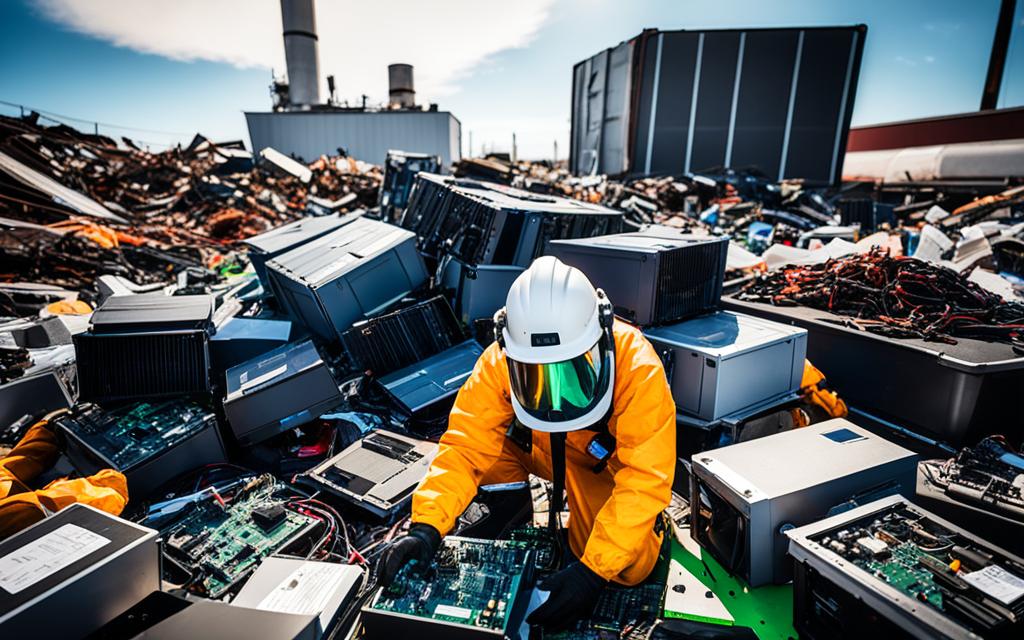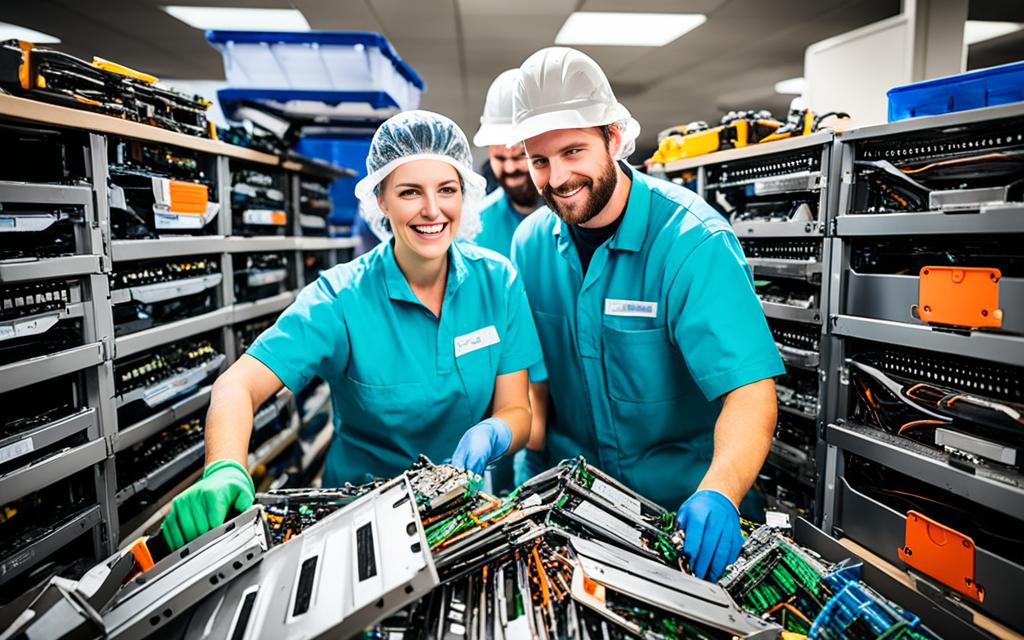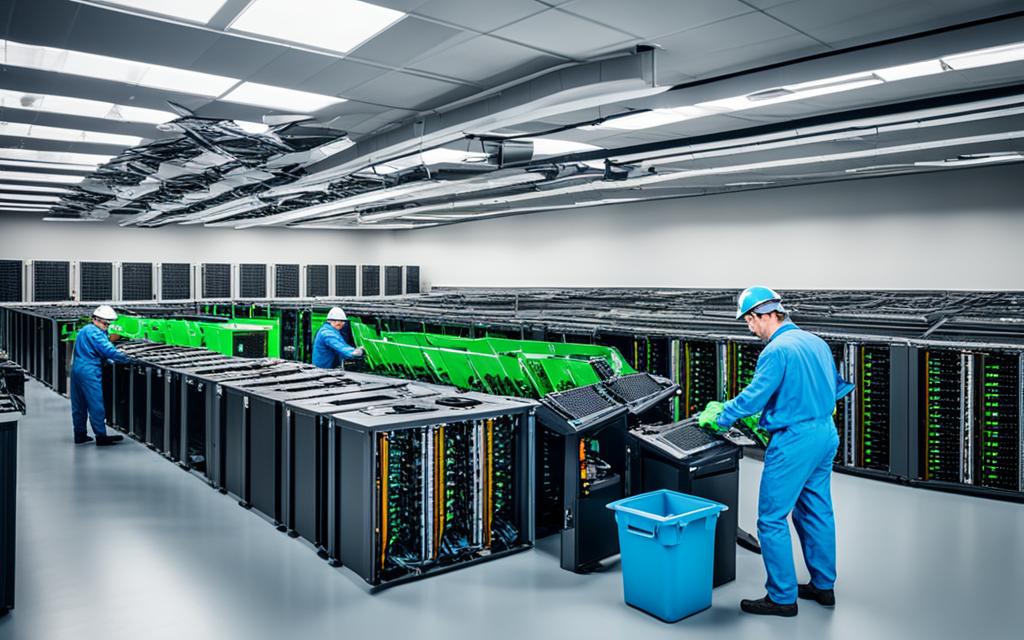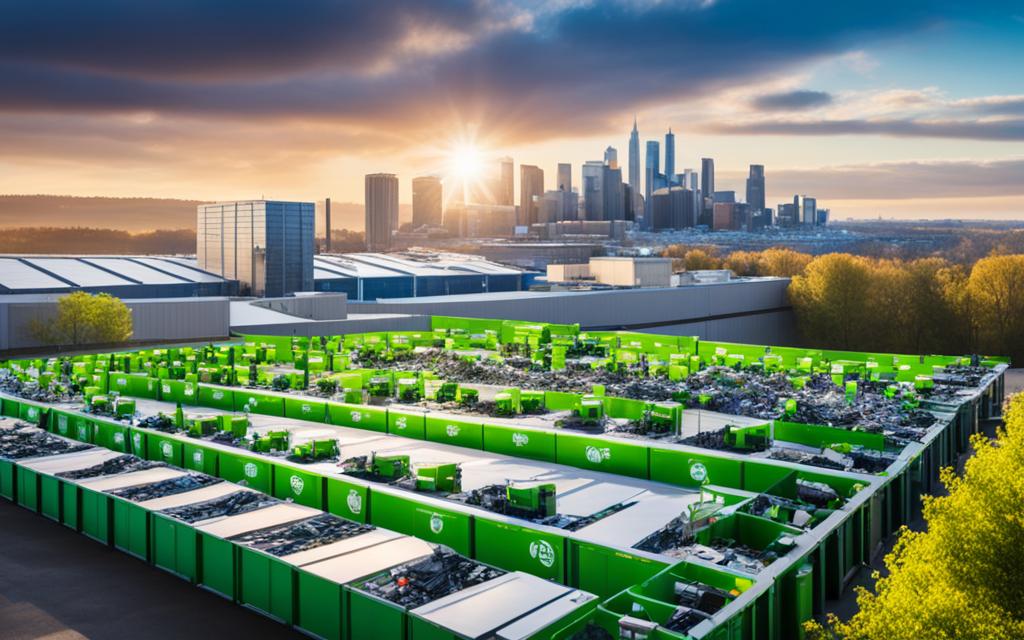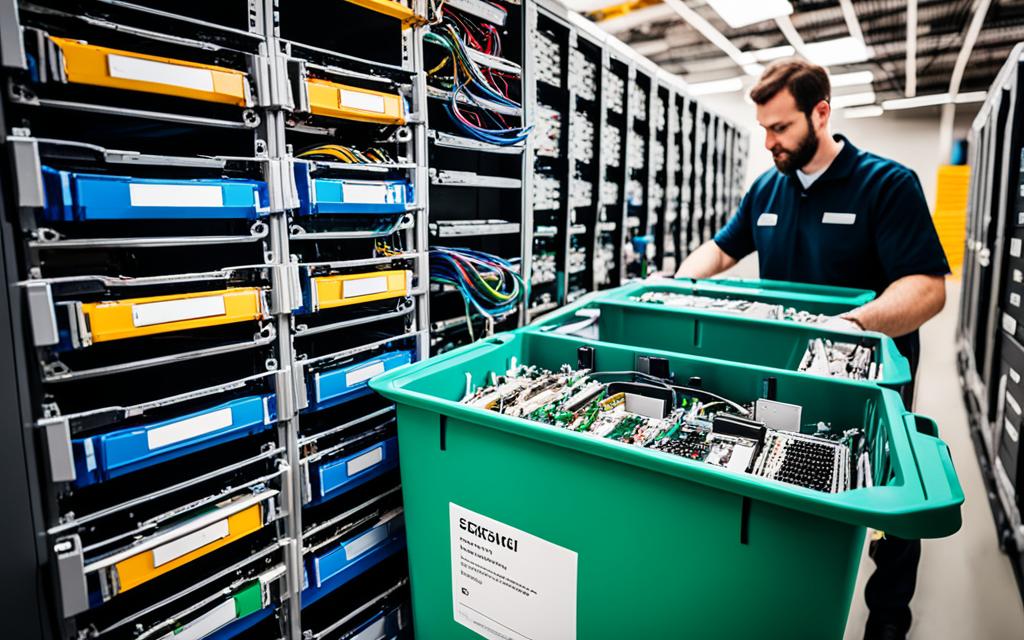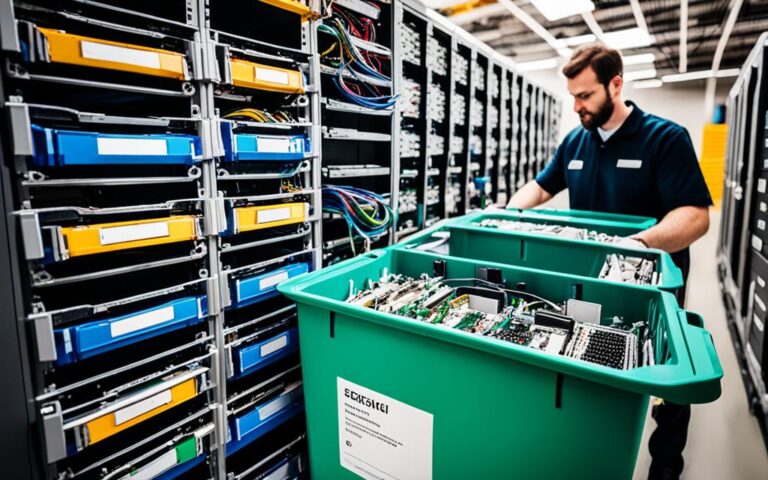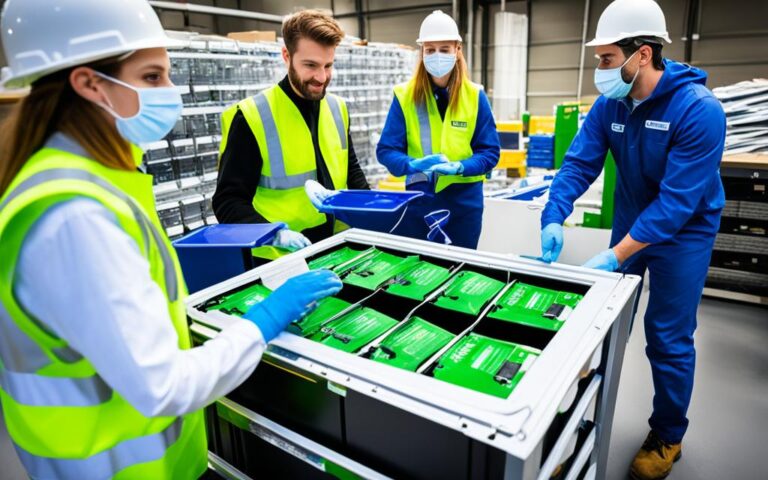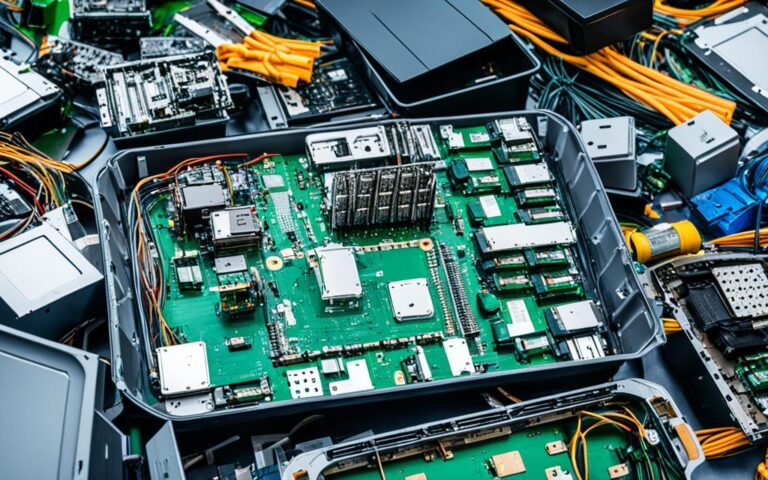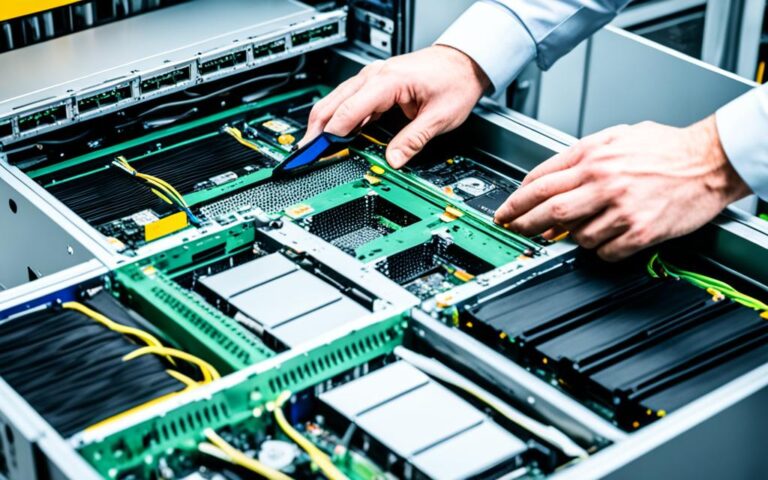Server Recycling: Strategies for Effective E-Waste Management
The world’s e-waste problem is growing rapidly, with projections indicating that global e-waste will almost double by 2030. Less than 20% of discarded electrical items are properly recycled, contributing to environmental pollution. The impact of server e-waste generated by data centers cannot be ignored. It’s time to take action and implement sustainable strategies for server recycling and e-waste management.
In this article, we will explore the current state of the e-waste problem, the specific challenges faced by data centers, and the impact of obsolete equipment. We will also delve into effective e-waste management strategies that data centers can adopt to reduce, reuse, and recycle server e-waste. By following these strategies, data centers can contribute to a greener future and create a sustainable approach to hardware lifecycles.
Join us as we delve into the world of server recycling and discover how data centers can make a positive difference in the realm of e-waste management. Together, we can create a more sustainable future for generations to come.
The Current State of the E-Waste Problem
In 2019, a staggering 53.6 million metric tons of e-waste were generated worldwide, with projections indicating a further 40% increase by 2030.
Less than 20% of discarded electrical items are properly recycled, contributing to the accumulation of e-waste in landfills and resulting in toxic pollution.
The improper disposal of e-waste not only harms the environment but also endangers human health. Addressing the e-waste problem is crucial for improving sustainability practices and future-proofing the IT sector.
The Impact of Improper E-Waste Disposal
Improper e-waste disposal has severe consequences on both the environment and human health. Discarded electrical items contain hazardous materials such as lead, mercury, and cadmium, which can seep into the soil and contaminate water sources. This toxic pollution not only affects local ecosystems but also poses risks to human populations residing near e-waste disposal sites.
“Proper e-waste management is essential for protecting our environment and safeguarding public health. By implementing sustainable practices and recycling discarded electrical items, we can minimize environmental pollution and create a cleaner, greener future for generations to come.”
The Devastating Scale of Global E-Waste
The scale of the global e-waste problem is alarming. With the increasing ubiquity of technology and shorter product lifecycles, the demand for new electronic devices continues to rise. Unfortunately, the management and disposal of discarded electrical items have not kept pace with this growth.
As a result, e-waste accumulates in landfills, releasing hazardous substances into the environment and causing irreversible damage. This not only affects the immediate surroundings but also has far-reaching consequences for global ecosystems.
| Continent | E-Waste Generated (metric tons, 2019) |
|---|---|
| Africa | 2.9 million |
| Asia | 24.9 million |
| Australia and Oceania | 0.7 million |
| Europe | 15.3 million |
| North America | 13.1 million |
| South America | 2.8 million |
The table above highlights the distribution of e-waste generation across different continents. It is evident that Asia and Europe are the largest contributors to the global e-waste problem, with Africa, North America, South America, and Australia and Oceania also significant contributors.
Addressing the e-waste problem requires a collective effort, involving individuals, businesses, and governments to implement sustainable practices and promote responsible consumption and disposal of electronic devices.
E-Waste Generated by Data Centers
Data centers are significant contributors to the growing problem of e-waste generation. The disposal of racks, computing equipment, monitors, circuits, and other electrical components leads to the generation of server e-waste. As the industry experiences rapid innovation, working equipment is often prematurely disposed of, further exacerbating the issue. To address this challenge, data centers need to adopt a sustainable approach by reducing, reusing, and recycling e-waste.
One effective strategy is to extend the lifespan of equipment through regular maintenance. By implementing thorough maintenance procedures, data centers can ensure that their computing equipment remains functional and efficient for longer periods, reducing the need for frequent replacements. This not only reduces e-waste generation but also helps optimize resource utilization and lowers costs.
Implementing energy-efficient practices is another crucial aspect of sustainable e-waste management in data centers. By optimizing power usage and employing energy-saving technologies, such as high-efficiency cooling systems and workload consolidation, data centers can significantly reduce unnecessary disposals of computing equipment. This not only minimizes e-waste but also contributes to environmental conservation by reducing overall energy consumption.
Furthermore, adopting a circular economy approach is essential in managing e-waste effectively. Data centers should prioritize reuse whenever possible. This includes repurposing components and equipment that are still functional but no longer required for their original purpose. By repurposing and redeploying hardware, data centers can significantly minimize e-waste generation and extend the useful life of computing equipment.
“Sustainable e-waste management in data centers requires a shift towards circular economy practices, where reducing, reusing, and recycling become integral parts of the lifecycle management process.”
Recycling plays a pivotal role in reducing the environmental impact of e-waste generated by data centers. Implementing proper recycling procedures ensures that valuable resources found in computing equipment, such as metals and rare earth elements, are recovered and reused in the production of new electronics. Partnering with certified e-waste recyclers and following best practices for recycling compliance are essential steps in achieving responsible e-waste management.
By adopting these sustainable practices, data centers can play a crucial role in mitigating the e-waste problem. Not only does this benefit the environment and reduce resource depletion, but it also promotes an industry-wide commitment to responsible and circular e-waste management.
| Data Center E-Waste Management Strategies | Benefits |
|---|---|
| Extending lifespan through regular maintenance | – Reduces e-waste generation – Optimizes resource utilization – Lowers costs |
| Implementing energy-efficient practices | – Reduces unnecessary disposals – Minimizes e-waste – Lowers energy consumption |
| Prioritizing reuse and repurposing | – Minimizes e-waste generation – Extends the useful life of computing equipment – Promotes resource conservation |
| Partnering with certified e-waste recyclers | – Recovery of valuable resources – Supports circular economy principles – Ensures responsible e-waste disposal |
The Impact of Obsolete Equipment
Obsolete equipment plays a significant role in contributing to the generation of server e-waste in data centers. As technology continues to advance at a rapid pace, older equipment becomes outdated and is often replaced with newer models. This constant cycle of replacement results in a substantial amount of discarded hardware, adding to the growing problem of server e-waste.
The wasteful approach of disposing of obsolete equipment has far-reaching environmental consequences. It not only leads to the depletion of valuable resources but also increases the demand for new materials and energy. This increased demand contributes to the overall environmental impact of e-waste, including pollution, greenhouse gas emissions, and habitat destruction.
Data centers must shift their mindset from one of disposability to one that emphasizes the importance of sustainable practices. Instead of discarding obsolete equipment, efforts should be made to extend its lifespan through proper maintenance and regular upgrades. By adopting a circular economy approach, data centers can repurpose or recycle components of obsolete equipment, reducing their environmental impact and minimizing the need for new resources.
Implementing measures to repurpose or recycle components of obsolete equipment not only reduces the amount of e-waste generated but also promotes resource efficiency. By salvaging reusable parts and materials, data centers can contribute to a more sustainable future by reducing the overall environmental impact of e-waste.
Benefits of Extending the Lifespan of Equipment:
- Reduces the demand for new resources and raw materials
- Lowers energy consumption associated with manufacturing new equipment
- Minimizes the amount of e-waste destined for landfills
- Promotes resource efficiency and the circular economy
“By extending the lifespan of equipment, data centers can play a crucial role in reducing the environmental impact of e-waste and creating a more sustainable future.”
In conclusion, the impact of obsolete equipment on server e-waste and the environment cannot be ignored. Data centers have a responsibility to prioritize sustainable practices and implement measures that extend the lifespan of equipment. By doing so, they can contribute to the reduction of e-waste generation and help create a greener and more environmentally conscious IT industry.
E-Waste Management Strategies
Data centers can adopt various strategies to effectively manage e-waste and minimize its environmental impact. By following the waste hierarchy of reduce, reuse, and recycle, data centers can play a significant role in promoting a more sustainable approach to e-waste management.
1. Reduce
The first step in e-waste management is to reduce the amount of new equipment purchased. By carefully evaluating the actual needs of the data center and implementing efficient resource allocation, data centers can minimize unnecessary equipment purchases. This not only helps reduce e-waste generation but also saves costs in the long run. Additionally, data centers can consider implementing cloud-based solutions and virtualization technologies to optimize server utilization, further reducing the need for physical hardware.
2. Reuse
Extending the lifespan of equipment through regular maintenance and repurposing older hardware are effective strategies for e-waste reduction. By implementing a strong hardware lifecycle management plan, data centers can ensure that equipment is properly maintained, repaired, and upgraded when necessary. Repurposing older hardware for less demanding tasks or donating it to educational institutions and non-profit organizations can also prevent premature disposal and give equipment a second life. Not only does this contribute to e-waste reduction, but it also promotes a more circular economy.
3. Recycle
Proper e-waste disposal is crucial for minimizing the environmental impact of data centers. Partnering with certified IT asset disposition operators ensures that e-waste is handled responsibly and materials are safely recovered. These operators have the expertise to dismantle and recycle electronic components, ensuring that valuable resources are extracted and hazardous materials are disposed of in an environmentally friendly manner. Data centers should prioritize working with operators that adhere to strict environmental and safety standards.
Furthermore, data centers can also implement internal recycling programs for smaller electronic components, such as batteries and cables. By providing designated collection points and educating employees about the importance of recycling, data centers can encourage responsible e-waste management at every level.
Conclusion
Proper e-waste management is crucial for safeguarding the environment, mitigating health risks, and paving the way for a cleaner and greener future. As the world grapples with the challenges posed by skyrocketing e-waste generation, informal recycling practices, inadequate infrastructure, and low awareness levels, it is vital to adopt a comprehensive approach that encompasses various sustainable practices.
Addressing the e-waste crisis requires a collective effort and innovative solutions. Extended producer responsibility, coupled with substantial investments in infrastructure, can lay the foundation for effective e-waste management. Educating consumers about the importance of responsible electronic waste disposal and implementing robust policies and regulations are indispensable in this journey towards sustainability.
Collaboration among stakeholders, adherence to certifications and standards, and continuous research and technological innovations are key drivers for achieving sustainable e-waste management practices. By embracing these measures, we can reduce the harmful impact of e-waste, conserve finite resources, and promote a circular economy. Let us take this opportunity to join forces and create a future where server recycling and responsible e-waste management are the norm.
FAQ
What is the current state of the global e-waste problem?
The world’s e-waste problem is growing rapidly, with projections indicating that global e-waste will almost double by 2030. Less than 20% of discarded electrical items are properly recycled, contributing to environmental pollution.
How do data centers contribute to e-waste generation?
Data centers play a significant role in contributing to the growing problem of e-waste. Disposal of racks, computing equipment, monitors, circuits, and other electrical components leads to the generation of server e-waste.
What is the impact of obsolete equipment on e-waste generation?
Obsolete equipment is a major contributor to server e-waste generated by data centers. As technology advances, older equipment is often replaced with newer models, resulting in a significant amount of discarded hardware.
What are some strategies for effective e-waste management?
Data centers can adopt various strategies to effectively manage e-waste and minimize its environmental impact. The waste hierarchy of reduce, reuse, and recycle can guide these strategies.
Why is proper e-waste management important?
Proper e-waste management is essential for protecting the environment, reducing health hazards, and creating a cleaner and greener future.
How can the e-waste problem be addressed?
The challenges of skyrocketing e-waste generation can be addressed through extended producer responsibility, investment in infrastructure, consumer education, policy and regulation, collaboration, certifications and standards, and research and technological innovations.

